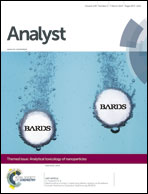Using citrate-functionalized TiO2 nanoparticles to study the effect of particle size on zebrafish embryo toxicity
Abstract
TiO2 nanoparticles (NPs) are photoactive, potentially producing toxicity in vivo in the presence of sunlight. We have previously demonstrated photodependent toxicity in zebrafish embryos exposed to TiO2 NPs. Here we investigate the effect of particle size on developing zebrafish exposed to 6, 12 and 15 nm citrate-functionalized anatase TiO2 NPs under either simulated sunlight illumination or in the dark. All three sizes of TiO2 NPs caused photo-dependent toxicity. Under simulated sunlight illumination, the acute toxicity of the 6 nm citrate-TiO2 NPs (120 h LC50 of 23.4 mg L−1) exceeded that of the 12 and 15 nm citrate-TiO2 NPs. Exposure to 6 nm particles under illumination also caused a higher incidence of developmental defects than the larger particles. These abnormalities included pericardial edema, yolk-sac edema, craniofacial malformation, and opaque yolk. To gain insight into the mechanisms of toxicity, we measured hydroxyl radicals (˙OH) generated by NPs in vitro and reactive oxygen species (ROS) produced in vivo. We found that on a mass basis, smaller particles generated higher levels of ROS both in vitro and in vivo, and the 6 nm citrate-TiO2 NPs induced more oxidative stress than larger particles in the zebrafish embryo. We examined oxidative DNA damage by measuring 8-hydroxydeoxyguanosine in zebrafish exposed to different-sized citrate-TiO2 NPs and found that 6 nm particles caused more DNA damage than did larger particles (12 and 15 nm) under illumination. Our results indicate a photo-dependent toxicity of citrate-TiO2 NPs to zebrafish embryos, with an inverse relationship between particle size and toxicity. Production of more ROS, resulting in more oxidative stress and more DNA damage, represents one possible mechanism of the higher toxicity of smaller citrate-TiO2 NPs. These results highlight the relationship between citrate-TiO2 NP size and toxicity/oxidative stress in developing zebrafish embryos.

- This article is part of the themed collection: Analytical Toxicology of Nanoparticles

 Please wait while we load your content...
Please wait while we load your content...